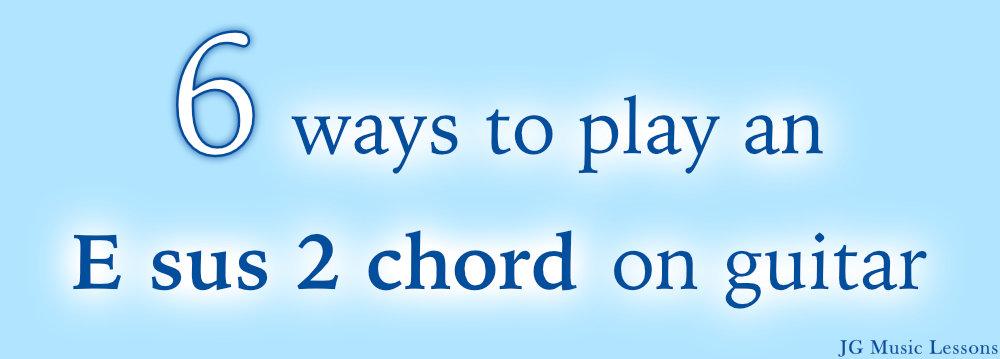After mastering your basic chords on guitar, you’ll also want to learn sus 2 chords which often come up in many popular songs. These chords have a cool, airy, open sound that will freshen up progressions. In this lesson, we’ll specifically be covering how to play the E sus 2 chord, which is short for “Suspended 2”.
This chord has an easy open shape but there are many different ways you can play it throughout the guitar fretboard. By knowing different chord variations, you’ll be able to use them in different musical contexts.
We’ll first go over some basic chord theory and then show you 6 ways to play an E sus 2 chord on guitar. Let’s get started!
E sus 2 chord theory
“Suspended 2” chord means that the 2nd degree replaces the 3rd of the chord. For example, a Major triad chord has the chord tones 1, 3, and 5 but a sus 2 chord has chord tones 1, 2, and 5.
This means that an E sus 2 chord has the chord tones E, F#, and B.
Here is the formula for sus 2 chords below.
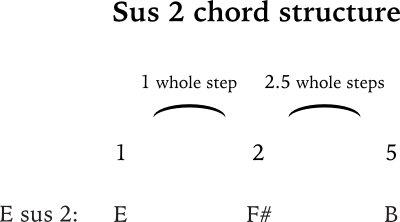
To compare, here are the notes for other chords with E as the root.
- E Major chord has the notes E, G#, B.
- E minor chord has the notes E, G, B.
If needed, check out this other post to understand the difference between sus 2 chords and add 2 chords.
Now that you know what notes belong to the chord structure, let’s look at how to read the chord charts.
How to read the chord charts
For the charts below:
- The top horizontal line of the chord chart represents the high E string and the bottom horizontal line represents the low E string.
- The vertical lines separate each fret.
- The numbers in the blue dots tell you which fingers to use on the fretting hand.
- The letters on the right of the charts tell you what notes you are playing on each string.
- Circles on the left represent open strings.
- Red X means to avoid that string.
You can check this link for more on how to read guitar notation symbols.
E sus 2 chord – open shape
For this first E sus 2 chord, we can use a power chord shape starting on the 5th string, 2nd fret while keeping the 6th, 2nd, 1st string open like this:
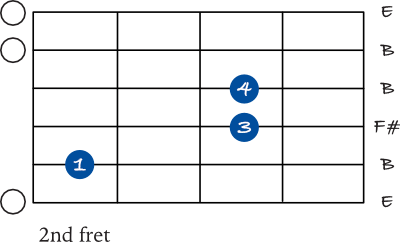
E sus 2 barre chord – 5th string
This next E sus 2 chord uses an open 6th string with a barre starting on the 5th string. This shape comes from shifting the open A sus 2 chord. You would barre the 7th fret and add the notes on 9th fret (3rd and 4th strings). This shape looks like a power chord, except you are also barring with your first finger.
If you can’t get the chord to sound clear, first try to get the notes from the 5th to the 2nd fret. As you develop more strength in your fingers, try adding the 1st string as well.
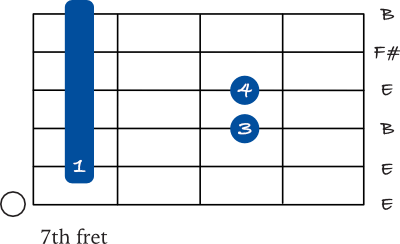
If needed, you can check out these 5 tips to get better at playing barre chords.
E sus 2 – 5th string variation
The following chord variation may be less commonly used but is also a good addition to your tool belt. The distance between the notes in the 5th and 4th string creates a unique cluster sound.
This chord originally comes from the open C sus 2 chord shape but we use the 1st finger to barre and shift the chord.
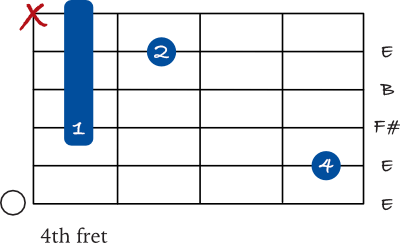
E sus 2 barre chord variation
For this chord shape, you also use a barre starting on the 5th string, 2nd fret while adding notes on the 2nd and 3rd string like this:


E sus 2 open chord variation
Here is another way to play this chord with the open 6th string using your 1st, 2nd, and 3rd finger. This variation may be more suitable for a finger picking style because of the gap between strings used.
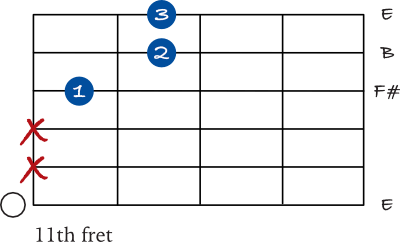
E sus 2 chord – 5th string
The following chord shape is trickier to play because of the wide stretch between your fingers. This variation would be more suitable for a rock style because of the way the notes are arranged in the lower strings.

Wrapping up
Sus 2 chords sound great as replacements or embellishment for Major chords to create an open sound. Try replacing these chords to add a little twist to chord progressions you already know. Experiment to get a feel for how these chords work best.
It’s good to know different variations of playing sus 2 chords because you have more flexibility to move around the fretboard and also when you need a specific note in the top to help define a melody that you are playing over.
I hope this helped you understand how to play an E sus 2 guitar chord or learn new ways of playing it. You can also try shifting the shapes that have all fretted notes to play other sus 2 chords on the same string.
📘 Get the free guitar practice guide here!
All the best,
JG Music Lessons
Start Playing Better, Faster
with Pro Membership! ✨
Get the guidance, tools, and support that keep your progress on track:
🏁 Always know what to practice next. Access the full Guitar Learning Roadmap with lessons in sequence.
🎼 Play songs with confidence. Step-by-step lessons of popular, classical pieces and other styles.
📙 Save time and frustration. Clear PDFs and ebooks that save time so you can focus on playing.
🎟️ Get rewarded for consistency. 2 free downloads every month (a $240+ yearly value).
🎁 Keep costs low while you grow. 50% off all charts, tracks, and posters — up to 75% off bundles.
🚫 Stay focused. Ad-free environment keeps you in the zone.
💬 Get help when you need it. Direct member support to keep you on track.

